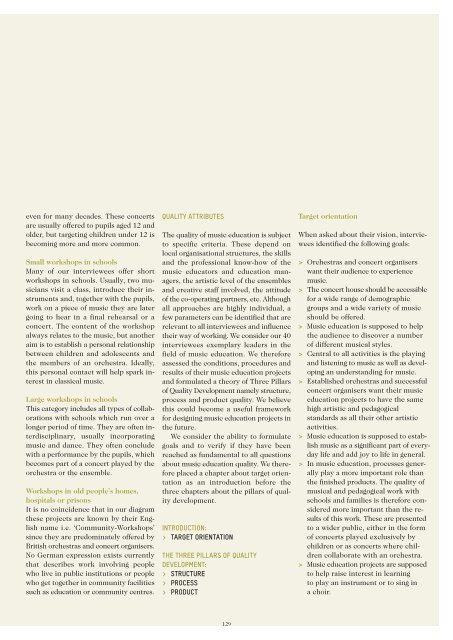exchange die kunst, musik zu vermitteln - Kunstdervermittlung.at
exchange die kunst, musik zu vermitteln - Kunstdervermittlung.at
exchange die kunst, musik zu vermitteln - Kunstdervermittlung.at
Erfolgreiche ePaper selbst erstellen
Machen Sie aus Ihren PDF Publikationen ein blätterbares Flipbook mit unserer einzigartigen Google optimierten e-Paper Software.
even for many decades. These concerts<br />
are usually offered to pupils aged 12 and<br />
older, but targeting children under 12 is<br />
becoming more and more common.<br />
Small workshops in schools<br />
Many of our interviewees offer short<br />
workshops in schools. Usually, two musicians<br />
visit a class, introduce their instruments<br />
and, together with the pupils,<br />
work on a piece of music they are l<strong>at</strong>er<br />
going to hear in a final rehearsal or a<br />
concert. The content of the workshop<br />
always rel<strong>at</strong>es to the music, but another<br />
aim is to establish a personal rel<strong>at</strong>ionship<br />
between children and adolescents and<br />
the members of an orchestra. Ideally,<br />
this personal contact will help spark interest<br />
in classical music.<br />
Large workshops in schools<br />
This c<strong>at</strong>egory includes all types of collabor<strong>at</strong>ions<br />
with schools which run over a<br />
longer period of time. They are often interdisciplinary,<br />
usually incorpor<strong>at</strong>ing<br />
music and dance. They often conclude<br />
with a performance by the pupils, which<br />
becomes part of a concert played by the<br />
orchestra or the ensemble.<br />
Workshops in old people’s homes,<br />
hospitals or prisons<br />
It is no coincidence th<strong>at</strong> in our diagram<br />
these projects are known by their English<br />
name i.e. ‘Community-Workshops’<br />
since they are predomin<strong>at</strong>ely offered by<br />
British orchestras and concert organisers.<br />
No German expression exists currently<br />
th<strong>at</strong> describes work involving people<br />
who live in public institutions or people<br />
who get together in community facilities<br />
such as educ<strong>at</strong>ion or community centres.<br />
QUALITY ATTRIBUTES<br />
The quality of music educ<strong>at</strong>ion is subject<br />
to specific criteria. These depend on<br />
local organis<strong>at</strong>ional structures, the skills<br />
and the professional know-how of the<br />
music educ<strong>at</strong>ors and educ<strong>at</strong>ion managers,<br />
the artistic level of the ensembles<br />
and cre<strong>at</strong>ive staff involved, the <strong>at</strong>titude<br />
of the co-oper<strong>at</strong>ing partners, etc. Although<br />
all approaches are highly individual, a<br />
few parameters can be identified th<strong>at</strong> are<br />
relevant to all interviewees and influence<br />
their way of working. We consider our 40<br />
interviewees exemplary leaders in the<br />
field of music educ<strong>at</strong>ion. We therefore<br />
assessed the conditions, procedures and<br />
results of their music educ<strong>at</strong>ion projects<br />
and formul<strong>at</strong>ed a theory of Three Pillars<br />
of Quality Development namely structure,<br />
process and product quality. We believe<br />
this could become a useful framework<br />
for designing music educ<strong>at</strong>ion projects in<br />
the future.<br />
We consider the ability to formul<strong>at</strong>e<br />
goals and to verify if they have been<br />
reached as fundamental to all questions<br />
about music educ<strong>at</strong>ion quality. We therefore<br />
placed a chapter about target orient<strong>at</strong>ion<br />
as an introduction before the<br />
three chapters about the pillars of quality<br />
development.<br />
INTRODUCTION:<br />
> TARGET ORIENTATION<br />
THE THREE PILLARS OF QUALITY<br />
DEVELOPMENT:<br />
> STRUCTURE<br />
> PROCESS<br />
> PRODUCT<br />
129<br />
Target orient<strong>at</strong>ion<br />
When asked about their vision, interviewees<br />
identified the following goals:<br />
> Orchestras and concert organisers<br />
want their au<strong>die</strong>nce to experience<br />
music.<br />
> The concert house should be accessible<br />
for a wide range of demographic<br />
groups and a wide variety of music<br />
should be offered.<br />
> Music educ<strong>at</strong>ion is supposed to help<br />
the au<strong>die</strong>nce to discover a number<br />
of different musical styles.<br />
> Central to all activities is the playing<br />
and listening to music as well as developing<br />
an understanding for music.<br />
> Established orchestras and successful<br />
concert organisers want their music<br />
educ<strong>at</strong>ion projects to have the same<br />
high artistic and pedagogical<br />
standards as all their other artistic<br />
activities.<br />
> Music educ<strong>at</strong>ion is supposed to establish<br />
music as a significant part of everyday<br />
life and add joy to life in general.<br />
> In music educ<strong>at</strong>ion, processes generally<br />
play a more important role than<br />
the finished products. The quality of<br />
musical and pedagogical work with<br />
schools and families is therefore considered<br />
more important than the results<br />
of this work. These are presented<br />
to a wider public, either in the form<br />
of concerts played exclusively by<br />
children or as concerts where children<br />
collabor<strong>at</strong>e with an orchestra.<br />
> Music educ<strong>at</strong>ion projects are supposed<br />
to help raise interest in learning<br />
to play an instrument or to sing in<br />
a choir.


